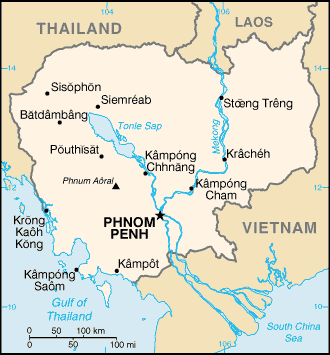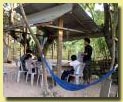

Make a donation.
Buy Adam a beer!
|
Volunteering and the Land Mine Museum
Dec 26, 2003
|
Go to...
|
Volunteering
12 hours on a bus and then a taxi ride; I arrive at the land mine museum not knowing if they needed volunteers or not.
Adam: "Are you Sally?"
Adam: "My name is Adam. I saw your post on Lonely Planet's
website. I'm here to volunteer."
Sally: "Can you start today? What perfect timing! I'm leaving tomorrow"
I didn't actually start until the next day.
Before I arrived at the museum there I had a picture of this job in my head. The kids had horrid injuries and disfigurements. The work was depressing, and challenging. Rewarding too, because I was doing noble work, helping kids in desperate need. I was pretty much wrong on all accounts.
Working with the kids is not depressing. After the first day you stop noticing their injuries. The kids are well fed and they go to school. They are generally happy, and are doing better than most Cambodians who live on the edge of starvation. The only time the job gets depressing is when I read about the lives they came from and how they got their injuries. Srei's story is about average for the kids living in the museum. He was collecting firewood one day when he stepped on a land mine. It took a full day by ox cart before he reached a hospital where they amputated half of his right leg. Last year, his mother asked Akira (the museum owner) to look after him. Srei arrived at the museum malnourished and completely unschooled. His mother left for Thailand to look for work and didn't know if she would ever be able to return. Srei is the newest of the kids, and he smiles at lot less than everyone else.
I'd imagined volunteering for a month would be incredibly rewarding - somehow this month would make a major difference in the kids lives. But that was just silly. Once the kids were in desperate need, but their lives have already been turned around. Cumulatively the English teachers and Japanese teachers (the kids are learning both) will make a difference by enabling the kids to find good work in the tourism industry. Individually, I am only making a small difference in their lives. Because I'm only making a small difference, I find the work to be less rewarding than I had expected.
The pace of life in Cambodia is unbelievably slow. There is no such things as rushing off to work. The bicycles and scooters in the street seem to be having a competition to see who can go the slowest. Once at work the pace of life doesn't pick up any. In Mexico there is an hour siesta - In Cambodia, it seems to last all day. The taxi drivers and waiters spend all day in a hammock when they aren't playing cards. I'm adopting to the Cambodian pace of life. I teach for an hour and half most days. From there I spend at least half of the "work day" laying in a hammock. Occasionally I gather the motivation to stand up and answer questions from tourists or even give a tour of the museum.
It's not as rewarding or challenging as I would have liked, but life at the museum does stay interesting. A new adventure every day. A few days ago Akira went de-mining in the jungle and killed a 200 pound wild boar. I'm told to peek into the big pot on the stove. Inside is the massive head of the boar boiling away for our dinner. Yesterday one of the Japanese volunteers suddenly became very ill with a high fever and chills. The initial diagnosis was malaria, but later reports are that it is "something intestinal". Tomorrow - Who knows what will happen?
The ad for the volunteer position offered room and board, but I only survived two nights of living at the museum. The museum is probably middle-class by Cambodian standards. There is more than enough food, electricity and a TV. But soft American living has left me unprepared for Cambodian living. The sleeping mats were unpadded enough that they left my shoulders and hips bruised. I considered moving into a hammock, but the weather gets cold at night. I shivered in bed for the two nights that I spent in the museum. A hammock would have even been colder. Instead I checked into a guesthouse in town. It's quite a deal, with the special volunteer rate. I'm paying $2/night including free laundry, free use of a bicycle and free weed.
The Land Mine Museum
The other half of my job is giving tours of the land mine museum. I followed Colin around on a couple of tours and declared myself officially ready enough to start giving tours. Since then I've increased my knowledge by talking with Akira, reading the mass of information on the museum walls, reading reports from Belgium Handicap International, reading the anti-personal mine treaty, and reading Jane's Complete Book of Landmines.
Here is the abbreviated, virtual land mine museum tour.
The scene:
3 wooden building, just a bit too solid to be described as shacks. One contains a couple of bedrooms. The second is a kitchen and the third is the museum. Between the buildings is a dirt courtyard containing a mess of war remnants, (bombs, rockets, land mines) and wildlife (dogs, cats, and chickens).
The land mine museum of Siem Reap is the work and story of one man - Akira. He is quiet and seems almost shy. His story is unreal and yet somewhat typical for Cambodia. His parents were killed by the Khmer Rouge when he was 5 years old. When he was 9 he joined the Khmer Rouge as a soldier. With stacks of weapons to choose from, kids usually chose the rocket launchers. Rocket launchers don't have the same kickback as an AK47s and the kids could lay on the ground when they fired them. At 13 he was captured by the Vietnamese army and was conscripted - fight for us, or we'll kill you. All throughout his career as a soldier he laid mines. In 1991, the UN came to Cambodia. Akira worked with them to start removing mines. After the UN left in 1993 Akira continued to remove mines. He still goes out de-mining a couple of times a month.
Inside the museum are even more bomb, rockets and mines. The walls are covered with stories and painting from Akira's life, and land mine spec. sheets. The tour goes around the museum from the anti-personal mines, to the anti-tank mines, to the shrapnel mines, and then on to unexploded ordinance (bombs and rockets). The most common type of mine in Cambodia is the "toe- popper". In every tour, someone says "I had no idea they were so small". They are about the size of your fist - designed to injure rather than kill. And they are made almost entirely made of plastic, so they're very difficult to find with a metal detector. In addition monsoon rains can bury them deeply under mud. If they're deep enough, they're impossible to find and stepping on them will not set them off. They disappear, until rain or construction can removes layers of dirt making them a hazard once again. The concept of an area being de-mined is a myth. There is no way to ever know if all of the mines have been removed.
Another myth is the "Hollywood land mine" that doesn't blow up until you step off of it. When you step on a mine, it goes boom!
A few facts:
=> There are still approximately 6 million mines in Cambodia. That's one mine
for every other Cambodian.
=> There were 700 injuries and 150 deaths from mines and unexploded bombs
in Cambodia last year. This number has been consistent for the past few years
and doesn't look like it will improve any time soon.
=> Worldwide 85% of the casualties from land mines are civilians not soldiers. In
Cambodia that figure is 98%.
Comments |
Go to...
|
Adam...you commented that you've only made a small difference. Don't assume that!
Some of those kids will undoubtedly have been touched by *something* you said or did, or by something neither you nor I would have ever thought of.
I know you don't work with kids so much but I do and take it from me...the potential to make a *huge* difference is *always* there.
Scott "Rabbit" Lacey - Sept 25, 2006
Hi Adam,
I was intrigued by your journal. I want to go to live in Cambodia. I live in Australia at present.
I want to praise you for your heart attitude. I think that it was a worthy cause which made you go there, and it sounds like you learnt something about being a human by going. Well done!
Could you help me at all in my efforts to go to Cambodia?
Anyway, god bless, Rabbit.
edwin cardona - May 12, 2007
adam my man' it takes alot of guts to go into cambodia to help these people .you did a good deed that will be remember for the rest of there lives .I have been in cambodia ,seam reap and phnom penh and have seen the victems of landmines. you are a good man with a good heart in the land called 'heart of darknes'I will be going back to cambodia in september of 2007 .I will like to meet you to shake you hand for helping these beautiful poor inocent people. Eddie from brooklyn new york
--
Thanks for the comment Edwin.
But I haven't been in Cambodia for a couple of years. I'm in Egypt these days.
-Adam




